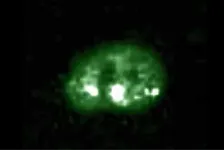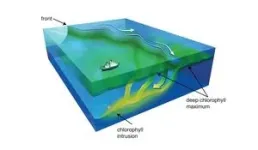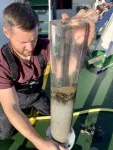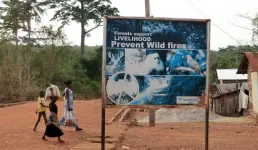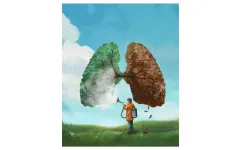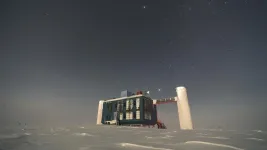(Press-News.org) Working with human breast and lung cells, Johns Hopkins Medicine scientists say they have charted a molecular pathway that can lure cells down a hazardous path of duplicating their genome too many times, a hallmark of cancer cells.
The findings, published May 3 in Science, reveal what goes wrong when a group of molecules and enzymes trigger and regulate what’s known as the “cell cycle,” the repetitive process of making new cells out of the cells’ genetic material.
The findings could be used to develop therapies that interrupt snags in the cell cycle, and have the potential to stop the growth of cancers, the researchers suggest.
To replicate, cells follow an orderly routine that begins with making a copy of their entire genome, followed by separating the genome copies, and finally, dividing the replicated DNA evenly into two “daughter” cells.
Human cells have 23 pairs of each chromosome — half from the mother and half from the father, including the sex chromosomes X and Y — or 46 total, but cancer cells are known to go through an intermediate state that has double that number – 92 chromosomes. How this happens was a mystery.
“An enduring question among scientists in the cancer field is: How do cancer cell genomes get so bad?” says Sergi Regot, Ph.D., associate professor of molecular biology and genetics at the Johns Hopkins University School of Medicine. “Our study challenges the fundamental knowledge of the cell cycle and makes us reevaluate our ideas about how the cycle is regulated.”
Regot says cells that are stressed after copying the genome can enter a dormant, or senescent stage, and mistakenly run the risk of copying their genome again.
Generally and eventually, these dormant cells are swept away by the immune system after they are “recognized” as faulty. However, there are times, especially as humans age, when the immune system can’t clear the cells. Left alone to meander in the body, the abnormal cells can replicate their genome again, shuffle the chromosomes at the next division, and a growing cancer begins.
In an effort to pin down details of the molecular pathway that goes awry in the cell cycle, Regot and graduate research assistant Connor McKenney, who led the Johns Hopkins team, focused on human cells that line breast ducts and lung tissue. The reason: These cells generally divide at a more rapid pace than other cells in the body, increasing the opportunities to visualize the cell cycle.
Regot’s lab specializes in imaging individual cells, making it especially suited to spot the very small percentage of cells that don’t enter the dormant stage and continue replicating their genome.
For this new study, the team scrutinized thousands of images of single cells as they went through cell division. The researchers developed glowing biosensors to tag cellular enzymes called cyclin dependent kinases (CDKs), known for their role in regulating the cell cycle.
They saw that a variety of CDKs activated at different times during the cell cycle. After the cells were exposed to an environmental stressor, such as a drug that disrupts protein production, UV radiation or so-called osmotic stress (a sudden change in water pressure around cells), the researchers saw that CDK 4 and CDK 6 activity decreased.
Then, five to six hours later, when the cells started preparations to divide, CDK 2 was also inhibited. At that point, a protein complex called the anaphase promoting complex (APC) was activated during the phase just before the cell pulls apart and divides, a step called mitosis.
“In the stressed environment in the study, APC activation occurred before mitosis, when it’s usually been known to activate only during mitosis,” says Regot.
About 90% of breast and lung cells leave the cell cycle and enter a quiet state when exposed to any environmental stressors.
In their experimental cells, not all of the cells went quiet.
The research team watched as about 5% to 10% of the breast and lung cells returned to the cell cycle, dividing their chromosomes again.
Through another series of experiments, the team linked an increase in activity of so-called stress activated protein kinases to the small percentage of cells that skirt the quiet stage and continue to double their genome.
Regot says there are ongoing clinical trials testing DNA-damaging agents with drugs that block CDK. “It’s possible that the combination of drugs may spur some cancer cells to duplicate their genome twice and generate the heterogeneity that ultimately confers drug resistance,” says Regot.
“There may be drugs that can block APC from activating before mitosis to prevent cancer cells from replicating their genome twice and prevent tumor stage progression,” says Regot.
Other researchers who contributed to the study include Yovel Lendner, Adler Guerrero-Zuniga, Niladri Sinha, Benjamin Veresko and Timothy Aikin from Johns Hopkins.
Watch this video of a cell going through the cell cycle stage of duplicating its genome twice without dividing.
Funding for the study was provided by the National Institutes of Health National Institute of General Medical Sciences (T32-GM007445, 1R35GM133499) and National Cancer Institute (1R01CA279546), the National Science Foundation and the American Cancer Society.
END
Scientists track ‘doubling’ in origin of cancer cells
2024-05-02
ELSE PRESS RELEASES FROM THIS DATE:
Human activity is causing toxic thallium to enter the Baltic sea, according to new study
2024-05-02
Woods Hole, Mass. (May 2, 2024) -- Human activities account for a substantial amount - anywhere from 20% to more than 60% - of toxic thallium that has entered the Baltic Sea over the past 80 years, according to new research by scientists affiliated with the Woods Hole Oceanographic Institution (WHOI) and other institutions.
Currently, the amount of thallium (element symbol TI), which is considered the most toxic metal for mammals, remains low in Baltic seawater. However, the research suggests that the amount of thallium could increase due to further anthropogenic, or human induced, activities, or due to natural or human re-oxygenation of the Baltic that could make the sea ...
NREL proof of concept shows path to easier recycling of solar modules
2024-05-02
The use of femtosecond lasers to form glass-to-glass welds for solar modules would make the panels easier to recycle, according to a proof-of-concept study conducted by researchers at the U.S. Department of Energy’s National Renewable Energy Laboratory (NREL).
The welds would eliminate the need for plastic polymer sheets that are now laminated into solar modules but make recycling more difficult. At the end of their useful lifespan, the modules made with the laser welds can be shattered. The glass and metal wires running through the solar cells can be easily recycled and the silicon ...
NREL invites robots to help make wind turbine blades
2024-05-02
Researchers at the U.S. Department of Energy’s National Renewable Energy Laboratory (NREL) have successfully leveraged robotic assistance in the manufacture of wind turbine blades, allowing for the elimination of difficult working conditions for humans and the potential to improve the consistency of the product.
Although robots have been used by the wind energy industry to paint and polish blades, automation has not been widely adopted. Research at the laboratory demonstrates the ability of a robot to trim, grind, and sand blades. Those necessary steps occur after the two sides of the blade are made using a mold ...
Scent sells – but the right picture titillates both eyes and nose, research finds
2024-05-02
Scented products with relevant images on their packaging and branding, such as flowers or fruit, are more attractive to potential customers and score better in produce evaluations, new research confirms.
And such images, the researchers conclude, are particularly effective if manufacturers and marketers choose pictures that are more likely to stimulate a stronger sense of the imagined smell – for example, cut rather than whole lemons. This, they say, suggests that as well as seducing our eyes, the images are stimulating our sense of smell.
The study, published online in the International Journal of Research in Marketing, could provide manufacturers and marketers ...
Low intensity light to fight the effects of chronic stress
2024-05-02
Some neurological disorders can be improved through photobiomodulation, a non-invasive technique based on the application of low-intensity light to stimulate altered functions in specific regions of the body. Now, a study published in the Journal of Affective Disorders reveals how photobiomodulation applied to the brain-gut axis is effective in recovering some cognitive alterations and sequelae caused by chronic stress. The study opens up new perspectives for applying the technique in future therapies for the treatment of neurological diseases in patients.
The article, based on the study of laboratory animal models, ...
Wildfires in wet African forests have doubled in recent decades
2024-05-02
American Geophysical Union
Press Release 24-19
2 May 2024
For Immediate Release
This press release is available online at: https://news.agu.org/press-release/africa-forest-fires-doubled-drying
Wildfires in wet African forests have doubled in recent decades
Climate change and human activities like deforestation are causing more fires in central and west Africa’s wet, tropical forests, according to the first-ever comprehensive survey there. The fires have long been overlooked.
AGU press contact:
Rebecca Dzombak, news@agu.org (UTC-4 hours)
Contact information ...
Dietary changes may treat pulmonary hypertension
2024-05-02
Blood vessels in the lungs aren’t like the others in the body. This difference becomes clear in pulmonary hypertension, in which only the lungs’ blood vessels stiffen progressively, leading to chronic lung disease, heart failure and death. The underlying reasons for this organ-specific vessel stiffening remained a mystery until University of Pittsburgh researcher Stephen Chan and colleagues made a surprising discovery about these blood vessel cells in patients with pulmonary hypertension—they’re hungry.
Chan, Vitalant Chair in Vascular Medicine and Professor of Medicine in the Division ...
UTA scientists test for quantum nature of gravity
2024-05-02
Einstein’s theory of general relativity explains that gravity is caused by a curvature of the directions of space and time. The most familiar manifestation of this is the Earth’s gravity, which keeps us on the ground and explains why balls fall to the floor and individuals have weight when stepping on a scale.
In the field of high-energy physics, on the other hand, scientists study tiny invisible objects that obey the laws of quantum mechanics—characterized by random fluctuations that create ...
SCAI announces recipients of 2024 early career research grants
2024-05-02
Today, the Society for Cardiovascular Angiography & Interventions (SCAI) announced the recipients of the 3rd Annual SCAI Early Career Research Grants. SCAI offers this initiative to support the next generation of interventional cardiologists, providing a platform for junior-level investigators within 10 years of completing an interventional cardiology fellowship to study high-priority, clinically important topics and have their findings disseminated through various professional channels. This year’s grants are funded by support from Edwards Lifesciences, Medtronic, and Shockwave Medical.
“Research funding is often ...
AI can tell if a patient battling cancer needs mental health support
2024-05-02
Researchers at UBC and BC Cancer have developed a new artificial intelligence (AI) model that can accurately predict if a person receiving cancer care will require mental health services during their treatment journey.
The AI uses natural language processing and advanced neural networks to analyze an oncologist’s notes from their first consultation appointment with a patient. While these appointments are typically highly focused on a patient’s medical history and treatment options, the AI picks ...
